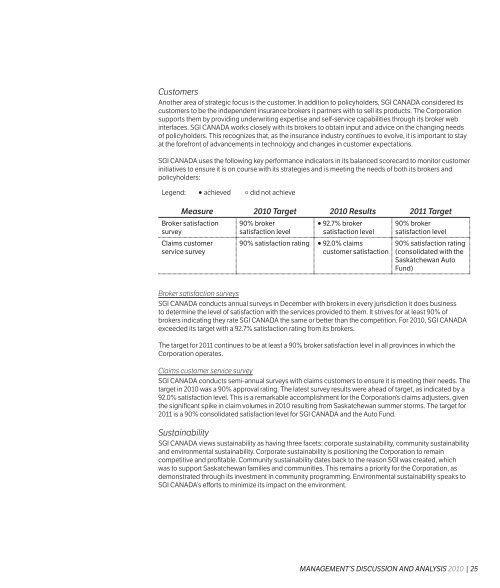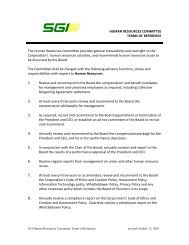Full report - SGI Canada
Full report - SGI Canada
Full report - SGI Canada
Create successful ePaper yourself
Turn your PDF publications into a flip-book with our unique Google optimized e-Paper software.
Off-Balance Sheet Arrangements<br />
<strong>SGI</strong> CANADA, in its normal course of operations, enters into certain transactions that are not required to be<br />
recorded on its Consolidated Statement of Financial Position – commonly referred to as the balance sheet.<br />
These items include litigation, structured settlements and a long-term telecommunications contract. These<br />
items are discussed below and in notes 8 and 21 to the consolidated financial statements.<br />
The Corporation, as is common in the P&C insurance industry, is subject to litigation arising in the normal<br />
course of its operations, primarily in claim settlements. The Corporation is of the opinion that current<br />
litigation will not have a material impact on its operations, financial position or cash flows.<br />
Also, the Corporation and its subsidiaries, in the normal course of settling claims, settle some long-term<br />
disability claims by purchasing structured settlements (annuities) from various financial institutions for<br />
its claimants. This is a common practice in the P&C industry. The net present value of the scheduled<br />
payments at December 31, 2010, was $49.2 million (2009 – $49.5 million).<br />
The Corporation provides a financial guarantee to the claimant in the event of default by the financial<br />
institution on the payment schedule to the claimant. No default has occurred in the past on these payment<br />
schedules and the Corporation considers the likelihood of such default as being remote.<br />
The Corporation has secured a long-term telecommunications contract with a related provincial Crown<br />
corporation that is scheduled to end in 2011. At December 31, 2010, the remaining commitment under<br />
these contracts was $790,000 (2009 – $2.4 million). The Corporation is also committed until 2011 for a<br />
systems support contract. At December 31, 2010, the remaining commitment is $1.1 million<br />
(2009 – $688,000). Each subsidiary is committed to leases on their office premises. Annual<br />
commitments related to these leases range between $20,000 to $427,000 over the next five years.<br />
Critical Accounting Estimates<br />
This discussion and analysis of the Corporation’s financial condition and results of operations is based<br />
upon its consolidated financial statements as presented in this annual <strong>report</strong>. These consolidated<br />
financial statements have been prepared in accordance with Canadian GAAP, as recommended by the<br />
Canadian Institute of Chartered Accountants. Significant accounting policies are contained in note 2 to the<br />
consolidated financial statements. Some of these policies involve critical accounting estimates because<br />
they require management to make particularly subjective or complex judgments about matters that are<br />
inherently uncertain and because of the likelihood that materially different amounts could be <strong>report</strong>ed<br />
under different conditions or by using different assumptions.<br />
The Corporation has discussed the development, selection and application of its key accounting policies,<br />
and the critical accounting estimates and assumptions they involve, with the Audit and Finance Committee<br />
of the Board of Directors. The Audit and Finance Committee has reviewed the disclosures described in<br />
this section. The most significant critical accounting estimates involve the provision for unpaid claims,<br />
impairment of investments, reinsurance, income taxes and employee future benefits.<br />
Provision for unpaid claims<br />
A provision for unpaid claims is maintained to cover the estimated ultimate liability for losses and loss<br />
adjustment expenses for <strong>report</strong>ed claims and claims incurred but not yet <strong>report</strong>ed (IBNR) as at the end of<br />
each accounting period. The initial provision is determined on the <strong>report</strong>ed facts filed with the claim and<br />
then revised regularly, as more information on the claim becomes known. The provision does not represent<br />
the exact calculation of the liability owing to claimants, but is an estimate developed using Canadian<br />
accepted actuarial practices and Canadian insurance regulatory requirements. The estimate reflects an<br />
expectation of the ultimate cost of settlement and administration of claims. It involves an assessment<br />
based on the facts and circumstances of the events <strong>report</strong>ed in the claim, the Corporation’s experience<br />
with similar claims, historical trends involving claim payments, claim severity, the effect of inflation on<br />
<strong>report</strong>ed and future claims, court decisions and the timeframe anticipated to settle and pay the claim.<br />
This provision is refined on a continual basis as prior fiscal year claims are settled and additional claims are<br />
<strong>report</strong>ed and settled. There may be significant time delays from the occurrence of the insured event and<br />
when it is <strong>report</strong>ed. If this occurs near the year-end date, estimates are made as to the value of these claims<br />
based on information known to the Corporation. As well, uncertainty exists for <strong>report</strong>ed claims that are<br />
not settled, as all necessary information may not be available. Thus, with the level of uncertainty involved<br />
in the claim process until the final settlement occurs, current reserves may not be sufficient. As permitted<br />
by Canadian GAAP, the Corporation only discounts long-term disability claims included in this provision.<br />
Any adjustments to these estimates, both positive (a redundancy or excess) and negative (a deficiency)<br />
are included in the provision for unpaid claims and are reflected as claims incurred in the current year’s<br />
Consolidated Statement of Operations.<br />
Impairment of investments<br />
When the market value of an investment falls below its cost, accounting standards require an assessment<br />
of whether the impairment in value is temporary or other than temporary. If it is determined that the<br />
impairment is other than temporary, the investment must be written down to market value. Management<br />
performs a quarterly analysis of investment holdings to determine if declines in market value of a particular<br />
investment are other than temporary. This analysis includes:<br />
○○<br />
Identifying all security holdings in an unrealized loss position that have existed for at least 12 months.<br />
○○<br />
Evaluating the size of the loss, both in percentage and absolute dollar terms relative to the market<br />
outlook for the security.<br />
○○<br />
For debt securities, evaluating the credit ratings from third-party security rating agencies or evaluating<br />
any change in payments on the security.<br />
Investments are written down to market value if it is determined that the loss is other than temporary, or if<br />
the investment manager has plans for disposition of the security in the near term.<br />
Reinsurance<br />
Reinsurance recoverable includes amounts for expected recoveries related to claim liabilities, as well as<br />
the portion of the reinsurance premium that has not yet been earned. The cost of reinsurance is accounted<br />
for over the terms of the underlying reinsurance policies using assumptions consistent with those used to<br />
account for the policies. Amounts recoverable from reinsurers are estimated in a manner consistent with<br />
claim and claim adjustment expense reserves, and are <strong>report</strong>ed in the Consolidated Statement of Financial<br />
Position. The ceding of insurance does not discharge the Corporation’s primary liability to its insureds. An<br />
estimated allowance for doubtful accounts is recorded on the basis of periodic evaluations of balances<br />
due from reinsurers, reinsurer solvency, management’s experience and current economic conditions.<br />
Income taxes<br />
The provision for income taxes is calculated based on the expected tax treatment of transactions recorded<br />
in the consolidated financial statements. In determining the provision for income taxes, the Corporation<br />
interprets tax legislation in a variety of jurisdictions and makes assumptions about the expected timing of<br />
the reversal of future tax assets and liabilities and the valuation of future income tax assets.<br />
Management makes assumptions regarding the value of future tax assets using a valuation allowance. This<br />
allowance is based on management’s assessment of whether it is more likely than not that the Corporation<br />
will utilize tax assets before they expire. This assessment is based on expected future earnings, tax rates,<br />
the amount of taxable income in future years and the timing of the reversal of future tax liabilities. No<br />
valuation allowance has been recorded in the current or prior year.<br />
50 | 2010 MANAGEMENT’S DISCUSSION AND ANALYSIS MANAGEMENT’S DISCUSSION AND ANALYSIS 2010 | 51















